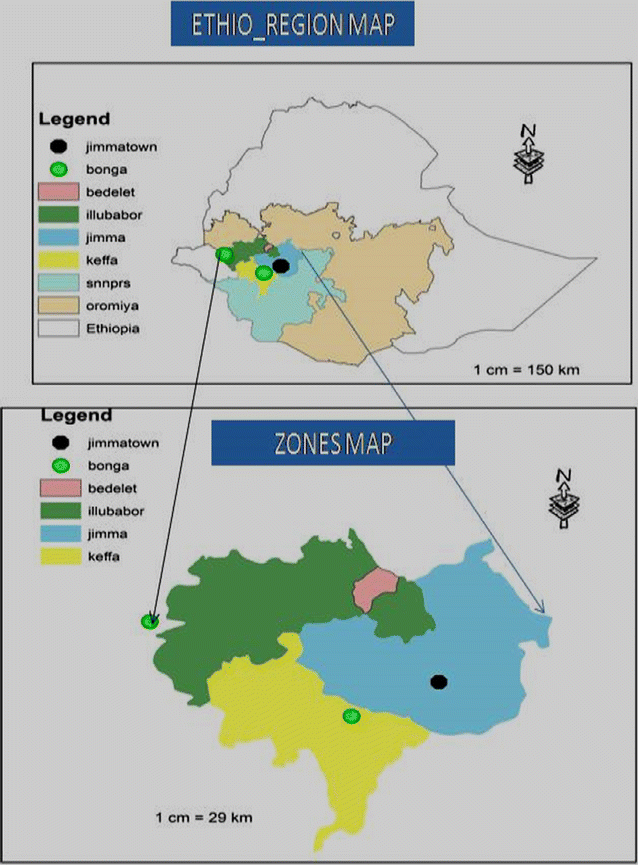Bluetongue disease in small ruminants in south western Ethiopia: cross-sectional sero-epidemiological study
- PMID: 29422081
- PMCID: PMC5806387
- DOI: 10.1186/s13104-018-3222-z
Bluetongue disease in small ruminants in south western Ethiopia: cross-sectional sero-epidemiological study
Abstract
Objective: The status of bluetongue disease, vectors for transmission of the disease and the serotypes involved are not clearly known in Ethiopia. This sero-epidemiological study was conducted to determine the seroprevalence and associated risk factors of bluetongue in small ruminants of South Western Ethiopia.
Result: 422 serum samples were screened for the presence of bluetongue virus (BTV) specific antibodies using competitive enzyme-linked immunosorbent assay (c-ELISA) and 30.6% (129/422) (confidence interval CI 26.2-35%) of the sheep and goat serum samples were found positive. Multivariate analysis of several risk factors like age, sex, altitude, body condition and species of animals were studied and it was observed that species of animals, age and altitude had significant influence (P < 0.05) on seropositivity to BTV. Goats showed more seropositivity to bluetongue as compared to sheep [AOR = 2.4, 95% CI (1.5-3.9), P = 0.001], adult animals were more seropositive [AOR = 3.1, 95% CI (1.9-5.1), P = 0.001] than other age groups and animals at the lowland [AOR = 3.1, 95% CI (1.5-6.4), P = 0.002] showed more seropositivity to bluetongue than midland and high land. Sex and body condition of the animals had no statistically significant (P > 0.05) effect on seropositivity to bluetongue.
Keywords: Bluetongue; Risk factors; Seroprevalence; Small ruminants; South West Ethiopia; c-ELISA.
Similar articles
-
Cross-sectional serosurvey and associated factors of bluetongue virus antibodies presence in small ruminants of Nepal.BMC Res Notes. 2014 Oct 6;7:691. doi: 10.1186/1756-0500-7-691. BMC Res Notes. 2014. PMID: 25288470 Free PMC article.
-
Epidemiology of bluetongue virus infection among small ruminants in Turkey: Seroprevalence and associated risk factors.Prev Vet Med. 2023 Apr;213:105871. doi: 10.1016/j.prevetmed.2023.105871. Epub 2023 Feb 13. Prev Vet Med. 2023. PMID: 36801648
-
Seroprevalence of Bluetongue Virus in small ruminants in Balochistan province, Pakistan.Transbound Emerg Dis. 2018 Oct;65(5):1272-1281. doi: 10.1111/tbed.12871. Epub 2018 Mar 31. Transbound Emerg Dis. 2018. PMID: 29604190
-
Bluetongue in India: a systematic review and meta-analysis with emphasis on diagnosis and seroprevalence.Vet Q. 2020 Dec;40(1):229-242. doi: 10.1080/01652176.2020.1810356. Vet Q. 2020. PMID: 32886028 Free PMC article.
-
Prevalence and risk factors of bluetongue virus infection in sheep and goats in China: A systematic review and meta-analysis.Microb Pathog. 2021 Dec;161(Pt A):105170. doi: 10.1016/j.micpath.2021.105170. Epub 2021 Sep 4. Microb Pathog. 2021. PMID: 34492305
Cited by
-
Seroprevalence and risk factors of bluetongue virus in domestic cattle, sheep, goats and camels in Africa: a systematic review and meta-analysis.Vet Q. 2024 Dec;44(1):1-12. doi: 10.1080/01652176.2024.2396118. Epub 2024 Aug 30. Vet Q. 2024. PMID: 39210745 Free PMC article.
-
Identifications, spatial distribution, and seasonal occurrence of Culicoides in selected districts of Northwest Ethiopia.Sci Rep. 2024 Oct 7;14(1):23267. doi: 10.1038/s41598-024-74524-z. Sci Rep. 2024. PMID: 39370423 Free PMC article.
-
Prioritizing smallholder animal health needs in East Africa, West Africa, and South Asia using three approaches: Literature review, expert workshops, and practitioner surveys.Prev Vet Med. 2021 Apr;189:105279. doi: 10.1016/j.prevetmed.2021.105279. Epub 2021 Jan 27. Prev Vet Med. 2021. PMID: 33581421 Free PMC article.
-
Serological and molecular prevalence study of bluetongue virus in small domestic ruminants in Morocco.Sci Rep. 2022 Nov 14;12(1):19448. doi: 10.1038/s41598-022-24067-y. Sci Rep. 2022. PMID: 36376352 Free PMC article.
-
Causes of abortion in Iranian sheep flocks and associated risk factors.Vet Res Commun. 2022 Dec;46(4):1227-1238. doi: 10.1007/s11259-022-09986-5. Epub 2022 Sep 6. Vet Res Commun. 2022. PMID: 36066737 Free PMC article.
References
-
- Maan NS, Maan S, Belaganahalli MN, Ostlund EN, Johnson DJ, Nomikou K, et al. Identification and differentiation of the twenty six bluetongue virus serotypes by RT–PCR amplification of the serotype-specific genome segment 2. PLoS ONE. 2012;7(2):e32601. doi: 10.1371/journal.pone.0032601. - DOI - PMC - PubMed
-
- Mogajane ME. Trade implications of bluetongue in Africa. Vet Ital. 2004;40(4):691–692. - PubMed
MeSH terms
Grants and funding
LinkOut - more resources
Full Text Sources
Other Literature Sources


